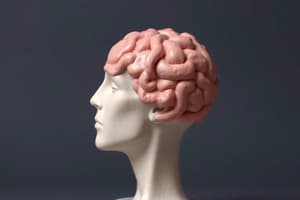Podcast
Questions and Answers
Which of the following are models of abnormal behavior? (Select all that apply)
Which of the following are models of abnormal behavior? (Select all that apply)
- Behavioral (correct)
- Bio-Psycho-Social (correct)
- Medical (correct)
- Psychodynamic (correct)
What does the medical model focus on?
What does the medical model focus on?
Organic causes of illnesses.
What is the psychodynamic model?
What is the psychodynamic model?
Mental illness is a product of unresolved issues that you have repressed.
What is the behavioral model?
What is the behavioral model?
What does the bio-psycho-social model include?
What does the bio-psycho-social model include?
The 3 Step Causal Pattern includes predisposing cause, precipitating cause, and ________ cause.
The 3 Step Causal Pattern includes predisposing cause, precipitating cause, and ________ cause.
What is the DSM?
What is the DSM?
Which of the following is a type of anxiety disorder? (Select all that apply)
Which of the following is a type of anxiety disorder? (Select all that apply)
What is generalized anxiety disorder?
What is generalized anxiety disorder?
What characterizes panic disorder?
What characterizes panic disorder?
What are phobias?
What are phobias?
What is OCD?
What is OCD?
What does PTSD stand for?
What does PTSD stand for?
What defines a psychological disorder?
What defines a psychological disorder?
What does maladaptive mean?
What does maladaptive mean?
What is the controversy over ADHD diagnoses?
What is the controversy over ADHD diagnoses?
How do the medical model and biopsychosocial approach differ?
How do the medical model and biopsychosocial approach differ?
Why do some psychologists criticize diagnostic labels?
Why do some psychologists criticize diagnostic labels?
Is poverty a risk factor for psychological disorders?
Is poverty a risk factor for psychological disorders?
Flashcards are hidden until you start studying
Study Notes
Models of Abnormal Behavior
- Four main models: Medical, Psychodynamic, Behavioral, and Bio-Psycho-Social.
Medical Model
- Emphasizes organic causes of psychological illnesses.
- Treatment often involves pharmacological intervention.
Psychodynamic Model
- Associates mental illness with unresolved and repressed conflicts.
Behavioral Model
- Suggests behaviors are learned through operant conditioning.
- Treatment focuses on modifying external reinforcers to reshape maladaptive behaviors.
Bio-Psycho-Social Model
- Integrates biological, psychological, and social factors in understanding disorders.
3 Step Causal Pattern
- Predisposing Cause: Factors increasing susceptibility, such as genetic predispositions or strict upbringing.
- Precipitating Cause: Triggering events that elicit maladaptive behaviors.
- Reinforcing Cause: Elements that maintain and exacerbate unhealthy behaviors.
DSM-5 (2012)
- The Diagnostic and Statistical Manual of Mental Disorders.
- Provides standardized language and categories for diagnosing psychological conditions.
Anxiety Disorders
- Include Generalized Anxiety Disorder, Panic Disorder, Phobias, PTSD, OCD, and Conversion Disorder.
- Generalized Anxiety Disorder characterized by chronic anxiety without clear source.
- Panic Disorder involves intense panic attacks with absence of anxiety in between.
- Phobias represent irrational fears; most common example is Agoraphobia.
- PTSD features lingering memories and symptoms following trauma.
- OCD includes obsessions (unwanted thoughts) and compulsions (repetitive actions).
Mood Disorders
- Major Depressive Disorder requires meeting five out of ten diagnostic criteria within two weeks.
- Bipolar Disorder involves alternating phases of depression and mania.
Neurochemical Factors
- Low levels of serotonin and norepinephrine associated with mood disorders.
Psychological Disorders
- Defined as syndromes marked by significant disturbances in cognition, emotion, or behavior.
Maladaptive Behavior
- Actions that don't provide proper adjustment to environmental demands.
Classification of Disorders
- Classifying disorders helps in diagnosis and treatment, though DSM-5 has been criticized for being overly detailed.
Controversies in ADHD
- Diagnosis based on early childhood symptoms may reflect either greater awareness or potential overdiagnosis.
- Long-term impact of stimulant treatments for ADHD remains uncertain.
Critiques of Diagnostic Labels
- Labels from DSM can bias perceptions and carry moral implications regarding responsibility for actions.
- Many individuals with psychological disorders are nonviolent and often victims of violence.
Prevalence and Risk Factors
- Psychological disorders vary in prevalence across regions, with rates between 5% and 25%.
- Poverty is identified as a risk factor, contributing to the onset and duration of disorders, especially in severe cases like schizophrenia.
Types of Anxiety Disorders
- Three main types: Generalized Anxiety Disorder, Panic Disorder, and Phobias.
Generalized Anxiety Disorder
- Continual tension and apprehension, often leading to sleep deprivation and autonomic arousal.
Panic Disorder
- Characterized by sudden episodes of intense fear or dread.
Phobias
- Intense, irrational fears of specific situations or objects.
Obsessive-Compulsive Disorder (OCD)
- Involves persistent, unwanted thoughts and repetitive behavior patterns.
Post-Traumatic Stress Disorder (PTSD)
- Symptoms persisting weeks after a traumatic event, including flashbacks and heightened arousal.
Studying That Suits You
Use AI to generate personalized quizzes and flashcards to suit your learning preferences.




